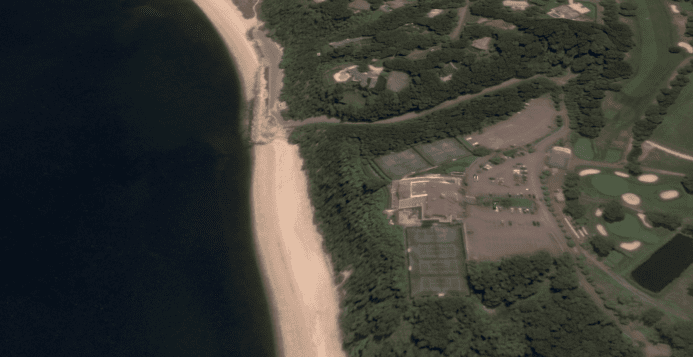Port Jeff beach continuing to erode as storms pummel the shoreline
A slumping bluff is raising eyebrows in Port Jefferson Village.
Bids are being accepted, and will continue to be through April 16, for a project that village officials hope will stave off erosion at Port Jefferson East Beach Area and Pavilion that is endangering a tennis court.
Port Jeff has been trying to figure out how to deal with its shrinking beach and slumping bluff at least as far back as early 2016. The new plan of action is to build a wall — it’s yet to be determined whether it will be built out of steel or a revetment of rocks — at the base of the bluff. Overhead images of the beach accessed via Google Earth show the shoreline nestled between the Long Island Sound and a bluff that leads to the grounds of the Port Jefferson Country Club clearly shrinking over the years. Officials are concerned about tennis court No. 4 at the country club, which has inched closer to the edge of the bluff as the beach has eroded.

“The Village of Port Jefferson’s shoreline suffered significant structural damage, resulting from multiple state-of-emergency storm events,” said a Jan. 17, 2017, letter from GEI Consultants, a privately-owned consulting firm contracted by Port Jeff, to the village regarding its concerns about erosion.
After the East Coast was hit with four storms classified as Nor’easters by the National Weather Service in March, a walkway and pavilion on the eastern end of the parking lot at the end of Village Beach Road was severely damaged, and many trees can be seen uprooted and horizontal at the bottom west of the road.
“That whole area East Beach is just a disaster,” Trustee Stan Loucks said during a March board meeting after taking a look at the area.
Trustee Bruce D’Abramo called it “scary” to see how badly the beach is eroding.
In an article entitled “Forgotten North Shore vulnerable to sea level rise” published by TBR News Media in January, R. Lawrence Swanson, the interim dean and associate dean of the Stony Brook University School of Marine and Atmospheric Sciences, said staving off erosion of bluffs is a complicated problem on the North Shore that will require more research from New York state.

“What can be done in the way of resiliency to preserve the character of the North Shore and yet also protect individual properties on the Sound — both those on the cliffs and those on the barrier spits?” he wrote. “Is hardening the bluffs and beaches at great expense the answer? Do we let nature take its course? Do residents on the barrier beaches have rights to the sediment of eroding cliffs in much the same way that downstream California claims rights to Colorado River water? If hardening of bluffs is allowed, will there be enough sediment at the toe to maintain a beach to reduce wave run-up? New York State needs to examine this issue and develop guidance that works for all.”
He warned that construction of sea walls can hinder the natural process of erosion from the base of North Shore bluffs, reducing the materials available to maintain barrier spits, or formations caused by the lateral movement of water along a shoreline, subjecting bluffs to “over washing.”
“Beaches fronting the bluffs will disappear so that waves will be beating directly on the seawalls,” he said. “This is a regional issue that cannot be solved property by property or even on a town-by-town basis. With the state of development on the North Shore, some form of intervention or adaptation is probably required; nature cannot be left totally unchecked, given the grim climate projections for this coming century.”

















